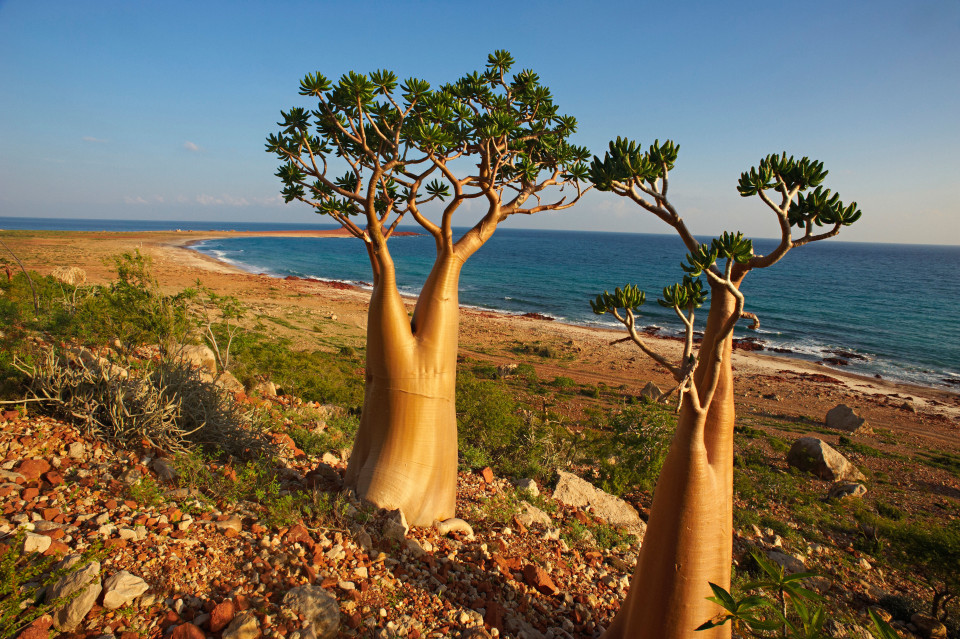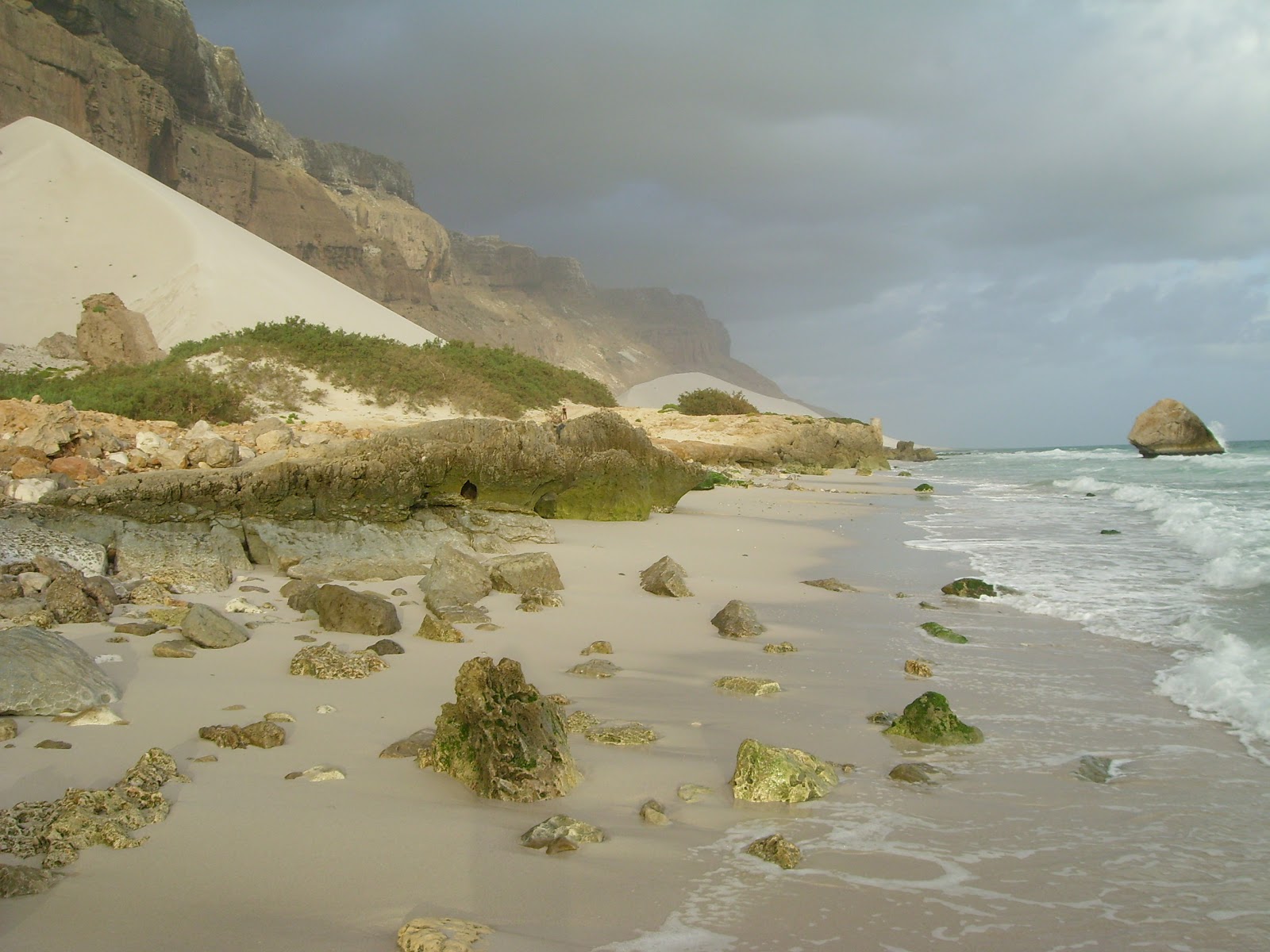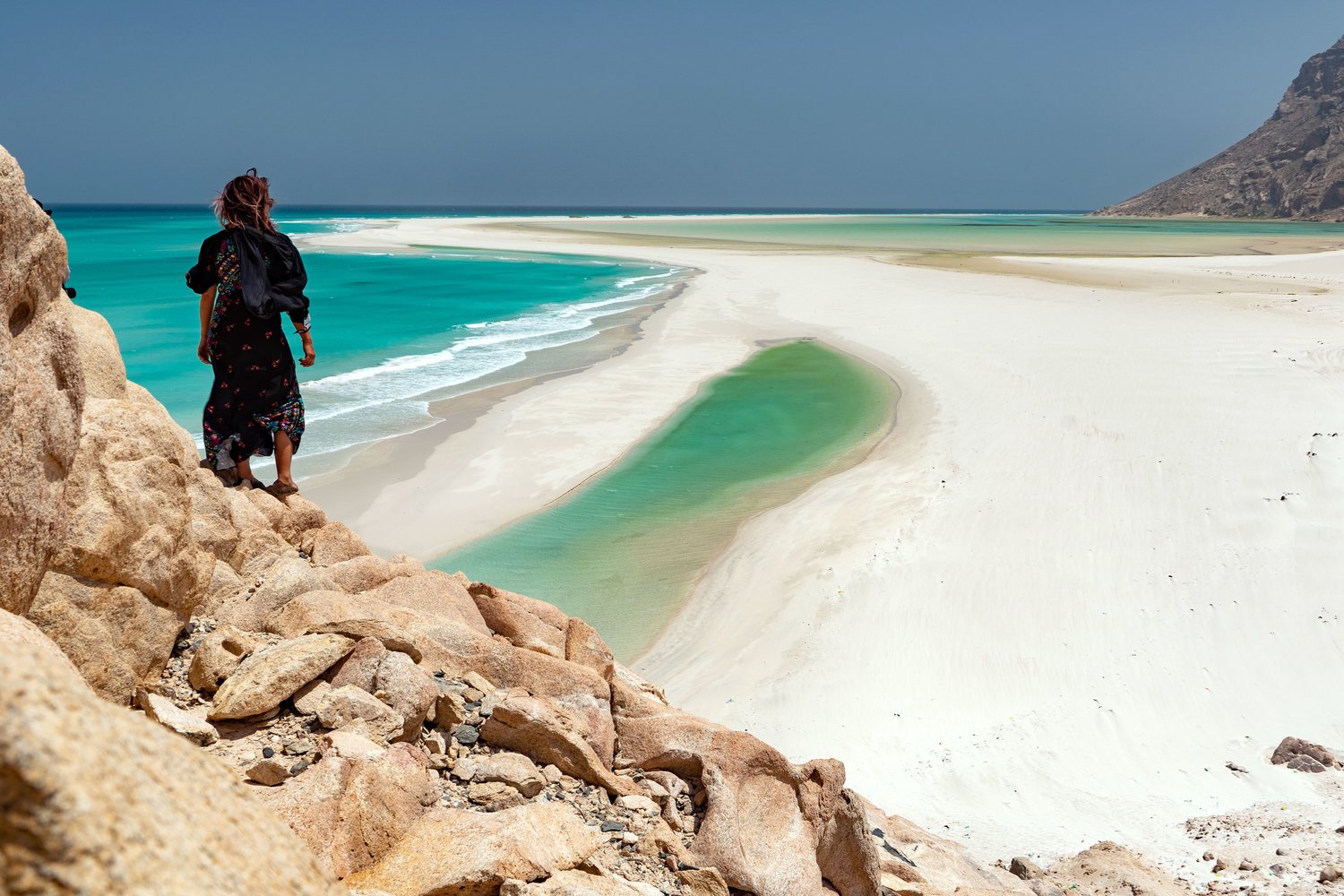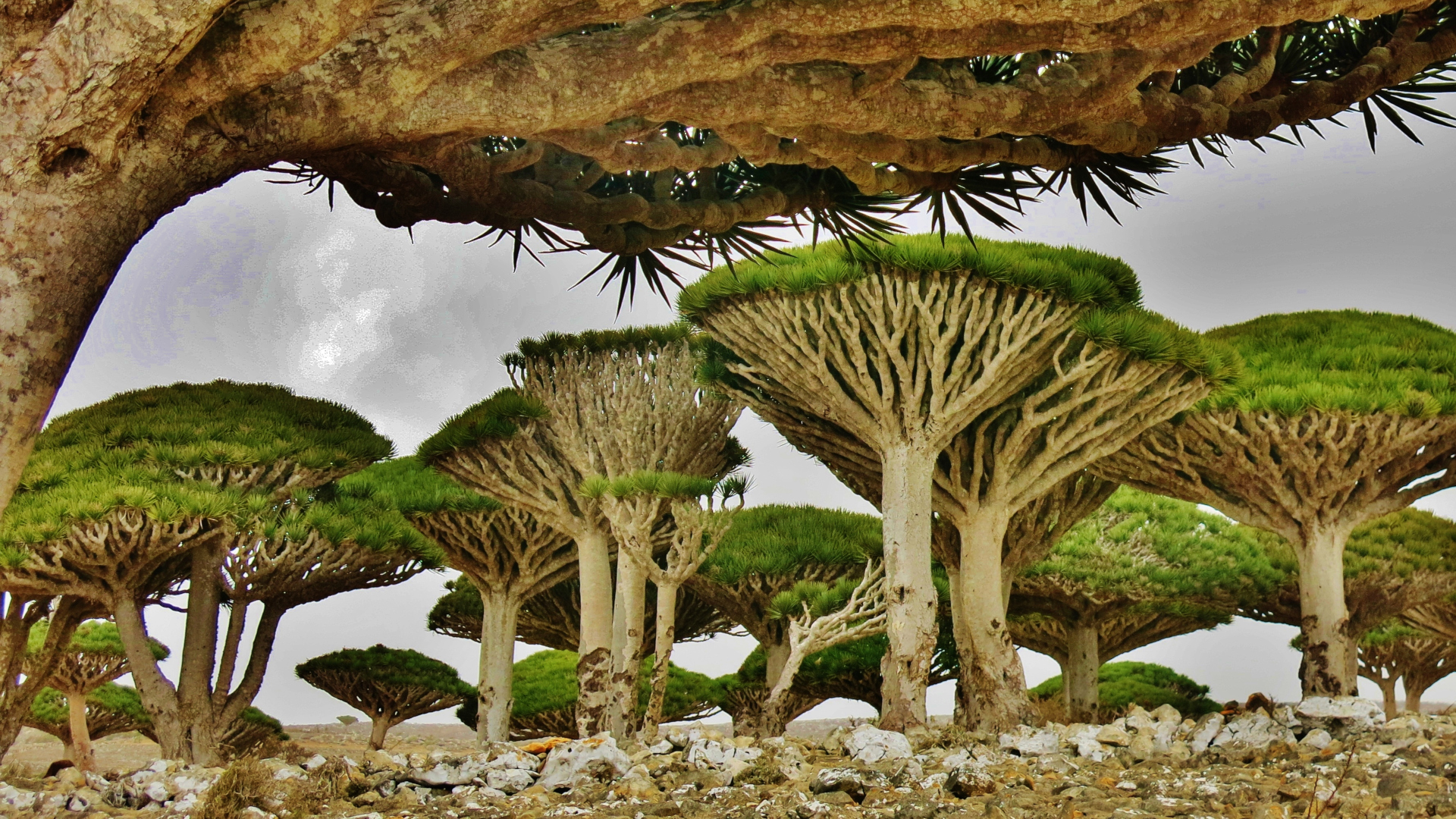Socotra is an offshore territory of Yemen, and an archipelago of one large island and three smaller islands in the Indian Ocean, near the “horn” of Somalia. Socotra is 78 miles long and 28 miles north to south. It‘s mainly a limestone plateau with karst topography, surrounded by narrow coastal plains. Gorgeous white sand beaches, rise to the Hajhir Mountains. (1,500 metres).
Due to its remarkable biodiversity, with over a third of the local plant species found nowhere else, Socotra has been designated a UNESCO World Heritage Site. With over 40,000 inhabitants, though, it’s not just a nature reserve.
The island is new to tourism, so this is not a luxurious vacation. The best accommodation is camping on the beaches. One can only go to Socrata by tour. The company arranges the visa, books the difficult-to-arrange flight from Abu Dhabi and arranges for a local jobber to conduct the tour.
Socotra is considered the jewel of biodiversity in the Arabian Sea. Described as the Most Alien-looking Place on Earth or the Arabian Sea’s Galapagos, Socotra is a naturalists’ haven,
A third of the 700 flora species are endemic. The long geological isolation and its fierce heat and drought have combined to create a ‘unique and spectacular endemic flora, most not found anywhere else in the world.
The endemic fauna includes six species of birds – the Socotra starling and sunbird. There’s only one endemic mammal (a bat), but 31 endemic reptiles (skinks, legless lizards, and one chameleon). The plants are endangered by non-native goats and the birds by non-native feral cats. There are over 120 species of birds and about 190 species of butterflies. There is so much beauty all around the island.
The interior of the island is dominated by the beautiful and green Hagghier mountains and limestone plateau. This is the richest area for endemic plant species. Other endemics are found throughout the island in every type of vegetation.
One of the most famous plants is the dragon’s blood tree “dracaena cinnabara” which exists only on Socotra and nowhere else on the Earth. The tree’s name comes from the dark red liquid sap that oozes out. The Desert Rose (adenium obesium) looks like a blooming elephant leg. The strange and rare Cucumber Tree is common at higher elevations.
Day 1 Flight AUH-SCT @08:55-10:20
I was surprised at the rugged mountains above Hadibo. It was also surprisingly green.
Delisha Beach. Nice swim in the warm water, minimal surf.

Day 2 Hadibo -– Arher Beach
Homhil National Park. High in the mountains, it is accessed by a 4WD switchbacking road up a Hogsback. The plants changed from small acacia and desert bush, to bottle trees and some flowering Desert Rose. There were fewer “cucumber trees, light gray with a more slender “bottle-like” trunk. Dragon’s Blood Trees became more common as we climbed.
We stopped at a village and walked about ½ hour down a limestone wadi with pools to a large natural pool, almost an infinity pool with a great view of the ocean far below. It was a great swim in the warm water. Sweet little boys were selling dragon blood resin and frankincense.


Arher Beach (northeast). This was a great place to swim with gorgeous white sand, no surf and a gently sloping beach. I was in the water for the whole hour we were here. A creek with a small waterfall falls onto the sand for a nice rinse. A large, covered cistern of water was next to the road. Next to the beach is a 100+ metre dune and next to it another 170 m sand dune, the largest in Socrata. Both dunes climb the high, steep limestone cliff. It is near the fishing village of Ras Irisseyl,

We then drove another 15 minutes to the easternmost point of Socotra where the Indian Ocean and the Arabian Sea meet. A huge blue whale vertebrae is a monument. Many large, yellow crabs dug large holes on the beach producing cones of sand.
Our constant companions at every camp are Egyptian vultures, a medium-sized vulture. They are white and yellow with a scraggly few feathers at the back of their head and a typical carrion-eating beak.
ON. East Point.
Day 3 Northeast.
Hoq Cave in Terbak village. The cave is three kilometres long, with a water pool. The formations are very mediocre. We had the option of hiking the 2-hour up to Hoq Cave. Only Veronica went. When they returned, the guide was completely knackered. Veronica did the hike up in one hour (20 minutes down) faster than anyone he had guided in his 100+ times to the cave.
DIhamri Marine Protected Area – campground, snorkelling. The fish were quite nice with several types of parrot fish, needlenose fish, moray eel, rays and turtles. The coral was not bleached but also not very colourful.
ON Dihamri Marine Protected Area campground.



Day 4 Southeast
Momi Plateau. Climb onto the plateau on a good paved road for the long drive to the Wadi. Frankincense trees, cucumber trees, bottle trees and views down into the wadi.
Wadi of Kalisan. Park on the edge of the wadi using some old rusted shipping containers to provide shade and a welcome cool breeze. The hike to the big pool in the wadi takes about 30 minutes. The only steep part is at the top and then a gradual grade as the trail goes upstream. The inner canyon is spectacular with dazzling white 10-metre walls. The water in the 100-metre-long pool was quite cool for a very refreshing swim. Our guide jumped from a 10 m cliff. There is a waterfall at the upstream end but it was too far a swim for me.

Bottle Trees. We had a great lunch in the rusted container but the goats were a menace. They walked through, tried to eat out of your bowl and were constantly in the garbage.
Wadi Defarhu. One of several dry wadis crossed on the way to Omak. Cement roads had been built through the wadis. With no culverts, several were eroded and broken up. There were several “wild” camels.
Sand Dunes of Hayf and Zahek. A large white sand dune complex.
ON Omak Beach Campground. Big dumping surf.
Day 5 Sat May 18
Dagub cave. A shallow cave with a broad high roof accessed by a short climb. Unusually, all the speleothems are at the entrance many right at the edge. There are three massive columns, the biggest I have ever seen. There was enough water dripping that I was able to get drenched. There were a large guano pile so there must be bats. Many swallows.
We went to the tiny shop in the village: potatoes, onions, oranges and apples with a scale, 1/3 candy, and 1/3 cleaning products. There were many little boys, all excited to see us. Unfortunately, Sveti bought them candy.
Dixam Plateau. Drive up a good paved road to the plateau. The only trees are Dragon Blood trees – all large. Veronica and the guide climbed into one tree to the top and stuck their head out the top for a great picture. Look down into Derhur Canyon, a spectacular canyon with vertical limestone walls.

The road descended a 4WD low-range road to the bottom of the canyon. We had lunch at the bottom.
Firhmin Forest. We continued through the extremely rugged country up another 4WD low-range road on the other side of the canyon back up to the plateau through the forest – the last woodland comprised of Dragon’s Blood trees. There are an amazing number and variety of dragon blood trees. Most have a single straight trunk but a few have many trunks.

Day 6 Northwest
Soviet tanks. Three rusted-out Soviet tanks are placed facing the ocean surrounded by gravel berms.
Qualansiah Village is a large village on the ocean. Pass 4 more Soviet tanks and drive up to a saddle to look down to Detwah Lagoon, a marine protected area with sea birds and marine wildlife. A huge sweeping circle of sand encloses the lagoon.
ON Detwah Beach.
Day 7 Qalansiah beach boat ride. We saw a large school of spinner dolphins, some leaping and doing acrobatics. The ride went a long way along the coast west to Sha’ab Beach. We returned to the beach and then a long drive back to Hadibo.
ON Summerland Hotel, Hadibo.
Day 8 Departure Abu Dhabi (AUH) Flight SCT-AUH @11:50-15:05


